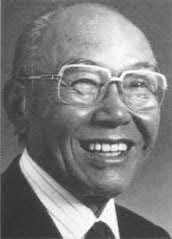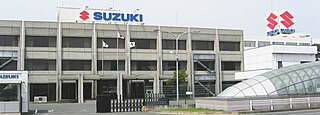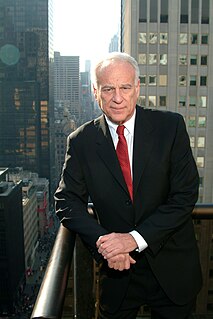
Soichiro Honda was a Japanese engineer and industrialist. In 1948, he established Honda Motor Co., Ltd. and oversaw its expansion from a wooden shack manufacturing bicycle motors to a multinational automobile and motorcycle manufacturer.

Suzuki Motor Corporation is a Japanese multinational corporation headquartered in Minami-ku, Hamamatsu, Japan. Suzuki manufactures automobiles, four-wheel drive vehicles, motorcycles, all-terrain vehicles (ATVs), outboard marine engines, wheelchairs and a variety of other small internal combustion engines. In 2016, Suzuki was the eleventh biggest automaker by production worldwide. Suzuki has over 45,000 employees and has 35 production facilities in 23 countries, and 133 distributors in 192 countries. The worldwide sales volume of automobiles is the world's tenth largest, while domestic sales volume is the third largest in the country.

The Subaru 360 is a rear-engined, two-door city car manufactured and marketed from 1958 to 1971 by Subaru. As the company's first automobile, production reached 392,000 over its 12-year model run.
The Toyota Group is a group of companies that have supplier, vendor and investment relationships with Toyota Industries and Toyota Motor vehicle manufacturing facilities. It is similar to a keiretsu in that no particular entity has outright control over the entire group, although unlike most keiretsu it does not contain a major bank.

Malcolm N. Bricklin is an American businessman, widely known for an unorthodox career spanning more than six decades with numerous prominent failures and successes — primarily manufacturing or importing automobiles to the United States, ultimately starting over thirty companies.
Subaru of America, Inc., based in Camden, New Jersey, is the United States-based distributor of Subaru's brand vehicles, a subsidiary of Subaru Corporation of Japan. The company markets and distributes Subaru vehicles, parts and accessories through a network of more than 600 dealers throughout the United States.

Lists of automobile-related articles cover a wide range of topics related to cars. The lists are organized by manufacturer, region, sport, technology and so on.

The Subaru 1000 was the first front wheel drive Subaru produced by Fuji Heavy Industries that was in the Japanese government "compact car" classification starting in 1966. Previous Subaru models such as the Subaru 360 and the Sambar had been rear-engined, rear wheel drive kei cars.
Powell Manufacturing Company (PMC) was a company based in southern California, widely known for its line of motor scooters that peaked in popularity in the late 1940s. From September 1954 to March 1957, Powell manufactured "Sport Wagon" pickup trucks and station wagons.

The Mitsubishi Silver Pigeon is a series of scooters made in Japan by Mitsubishi between 1946 and 1963. The first was the C-10, based on a scooter imported from the United States by Koujiro Maruyama, which began production at the Nagoya Machinery Works of Mitsubishi Heavy Industries. Along with the Mizushima three-wheeler pickup truck it represented Mitsubishi's first contributions to the Japanese post-war personal transport boom. The Silver Pigeon's primary competitor was the Fuji Rabbit. Motor scooters were so important to the post-war vehicle industry that In May 1948 both a Silver Pigeon and a Rabbit were presented to the Emperor of Japan. The Society of Automotive Engineers of Japan(in Japanese) lists the Silver Pigeon C-10 model introduced in 1946 as one of their 240 Landmarks of Japanese Automotive Technology.

The Yamaha DT is a series of motorcycles and mopeds produced by the Yamaha Motor Corporation. Models in the DT series feature an engine displacement of 50 to 400 cc. The first DT model, the DT-1, was released in 1968 and quickly sold through its initial 12,000 production run.

The first vehicle built by the automotive division of Fuji Heavy Industries was called the Subaru 1500, with the development code-name of P1. The prototype used a monocoque body structure and adopting the "ponton" style appearance, with an independent front wishbone suspension and a rear leaf spring suspension with three plates and a live rear axle.

A scooter or motor scooter is a motorcycle with a step-through frame and a platform for the rider's feet. Elements of scooter design were present in some of the earliest motorcycles, and scooters have been made since at least 1914. Scooter development continued in Europe and the United States between the World Wars.

Subaru (スバル) is the automobile manufacturing division of Japanese transportation conglomerate Subaru Corporation, the twenty-first largest automaker by production worldwide in 2017.

The Yamaha YA-1 is the first motorcycle produced by the Yamaha Motor Company. It was made from 1955 to 1958. This was also the first vehicle in Japan to have a primary kick start system. The Society of Automotive Engineers of Japan(in Japanese), includes the 1955 Yamaha 125YA-1 as one of their 240 Landmarks of Japanese Automotive Technology.

The automotive industry in Japan is one of the most prominent and largest industries in the world. Japan has been in the top three of the countries with most cars manufactured since the 1960s, surpassing Germany. The automotive industry in Japan rapidly increased from the 1970s to the 1990s and in the 1980s and 1990s, overtook the U.S. as the production leader with up to 13 million cars per year manufactured and significant exports. After massive ramp-up by China in the 2000s and fluctuating U.S. output, Japan is currently the third largest automotive producer in the world with an annual production of 9.9 million automobiles in 2012. Japanese investments helped grow the auto industry in many countries throughout the last few decades.

Subaru of Indiana Automotive, Inc. (SIA) is an automobile assembly plant in Lafayette, Indiana, which began as Subaru-Isuzu Automotive, Inc., a joint venture between Subaru Corporation and Isuzu Motors Ltd. Today, the plant is a wholly owned subsidiary of Subaru Corporation which produces the Ascent, Impreza, Legacy and Outback models. As Subaru's only manufacturing facility outside of Asia, SIA produces about half of all Subaru vehicles sold in North America.

Shinroku Momose was a Japanese aircraft/automotive engineer.
He is famous for the development of the Subaru 360, the Subaru Sambar and the Subaru 1000 series.

Tan Chong Motor Holdings Berhad, also known as the TCMH Group or simply Tan Chong Motor (TCM) is a Malaysia-based multinational corporation that is active in automobile assembly, manufacturing, distribution and sales, but is best known as the franchise holder of Nissan vehicles in Malaysia. The company was founded in 1957 by two Malaysian entrepreneurs, Tan Yuet Foh and Tan Kim Hor, with ambitions of importing and selling Datsun cars from Japan. Tan Chong Motor Holdings Berhad was incorporated on 14 October 1972, and in 1974, the company was listed on the Kuala Lumpur Stock Exchange.

















